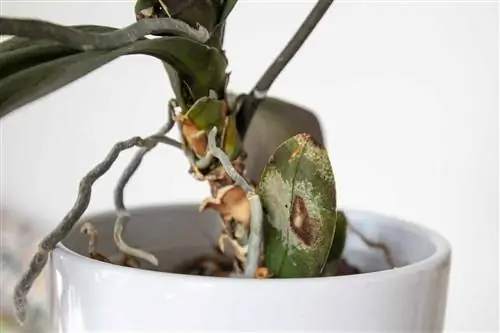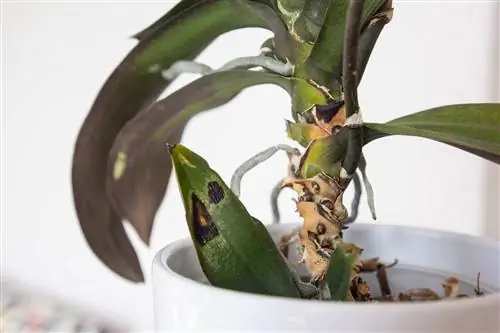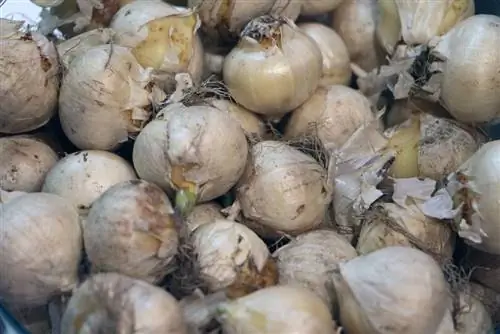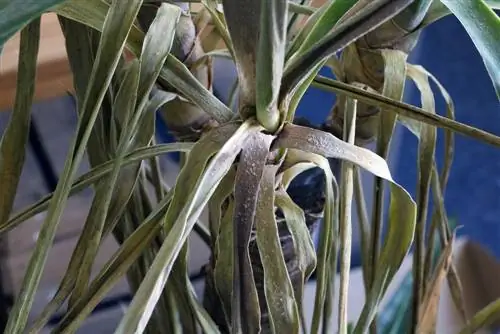- Author admin [email protected].
- Public 2023-12-17 03:39.
- Last modified 2025-01-24 12:45.
The fact that orchid diseases are unfortunately an issue is because their natural living conditions are very different from those in our living spaces. After all, not everyone has a tropical house in their garden. If something is wrong with the orchid, you first have to recognize it, then classify it correctly and treat it accordingly. Basically, it works no differently than it does for us humans. Mild cases can still be managed quite easily, but in severe cases it may be necessary to consult a specialist.
Demarcation
The example of falling leaves on an orchid is a good way to describe how closely you have to look to find the right cause. Only then can the right measures be taken.
Example: The leaves of an orchid turn yellow and fall off.
Totally normal
Most orchids shed a leaf or two from time to time. There are even genera that lose all their leaves at a certain point in time (before but also after flowering).
Fungal disease
In the initial phase, the spread of a fungus is still invisible. If you notice the external damage, it may already be too late for the orchid.
Quality
Many of the inexpensive orchids sold in supermarkets are “turbo-grown.” This means that they were grown in a short period of time with excessive amounts of fertilizer. Now it can happen that after two years it becomes limp and loses its leaves. It can only be nurtured again with a lot of patience.
Location
If the orchid is too dark, this will result in the leaves falling off. As they progress, diseases and pests can attack them.
Root damage
Damage to the roots can show up on the surface through leaf shedding. The cause is usually old substrate and too much moisture.
This is just a small excerpt of the causes that leaf dieback can have. So it's definitely worth taking a closer look and analyzing.
Diseases
There are three types of diseases that can be dangerous for an orchid:
- Fungal diseases
- Bacterial diseases
- Viral diseases
It is not always clear for the layperson to differentiate and it can often be too late when the first damage is visible. In all cases, however, the infected orchid must be separated from other plants immediately. All three pathogens are contagious and can spread to neighboring plants through touch and through the air.
Fungal diseases
If the leaves get brown-black, often sunken spots, it is usually black spot disease. It is usually caused by care errors:
- spraying the leaves too often in the evening hours
- watering too frequently during rest periods
- too high humidity
- poor ventilation

Now it's time to act quickly and isolate the plant immediately. Separate the affected leaves with a sharp and disinfected cutting tool. Then improve the care measures: First, avoid spraying completely or postpone it to the morning hours. Ensure a bright location and good ventilation. The types of fungi that cause these spots can vary. Different fungicides often only work against a specific species. It is only possible to differentiate here with the necessary specialist knowledge. Therefore, the use of fungicides after a self-diagnosis is rather inappropriate. Even home remedies don't help in every case. However, it is always worth a try before giving up on the plant completely.
The following home remedies can be used for any type of suspected fungal disease:
Cinnamon
To do this, dissolve 1 teaspoon of cinnamon in a cup of water by stirring vigorously. This mixture is then applied to all the leaves of the orchid with a brush.
garlic
To make a garlic broth, crush approx. 5 cloves and pour hot, no longer boiling water on them. This mixture is left to steep overnight. The broth is then filtered off and placed in a spray bottle. Now it is sprayed undiluted onto the leaves. Diluted 1:1 with water, you can also water the orchid with it.
Charcoal powder
To limit further spread, it is also recommended to sprinkle the stains with charcoal powder. However, you are unlikely to catch all the spores with this and it can only be a kind of first aid. An ugly, white-gray coating on the leaves suggests gray mold. This disease is often introduced when the plant is purchased. Gray mold tends to form when there is poor ventilation and too much moisture, such as in packaging with plastic film. A particularly common fungal disease can particularly affect the Vanda and Ascocenda species: Thai desease. This fungus climbs from below into the conductor tracks of the leaves. By the time you notice leaf loss, it is usually too late. But sometimes the orchid has formed roots in the upper parts of the plant, almost as an emergency program. You can cut off this head cutting and try again. Unfortunately, the plant itself can no longer be saved.
Bacterial infection
A bacterial infection can only be recognized by small, brown and sharply defined spots on the leaves. It may be slimy and moist around the spots. They become larger and larger and cause the leaves to die. Orchids with softer leaves, such as the Phalaenopses species, seem to be particularly susceptible to this, especially in winter or when they otherwise receive too little light. Then immediate damage control is required. The plant must be placed separately and the entire area must be thoroughly cleaned and disinfected. Hydrogen peroxide is suitable for this. The damaged leaves are carefully removed with a disinfected knife. The plant itself and the neighboring plants must be dipped in a disinfectant suitable for orchids. When doing this work, don't forget to disinfect your hands and tools with every cut. Lapacho tea is often recommended as a gentle agent for disinfecting orchids. Maybe it's worth a try: Add 2 tablespoons of lapacho bark to a liter of water and boil it for a few minutes, then let it steep and immerse the plants in it. From the measures you can already see that bacteria are not to be trifled with and it may be better to dispose of the affected plant completely before the bacteria spread further. For larger cultures, you should definitely consult a specialist.
Virus Infection
A viral infection is noticeable through many small, streaky and arrow-shaped spots on the leaves. Here too, it is very difficult for the layperson to tell whether it is viruses or bacteria. While thorough disinfection can still be effective against bacteria, there is hardly any remedy against virus infection. Fortunately, viral infections are not common. The Cymbidium, Cattleya and Odontoglossum appear to be particularly susceptible. The plants should definitely be kept isolated until final clarification by appropriate specialists. Viruses are usually transmitted through pests and unclean cutting tools.
Tip:
As a precaution, always make cuts on an orchid with disinfected tools. Daily watering should include a thorough inspection of the plant for pests.
Rot
Fungal and bacterial diseases in particular are often preceded by rot. The cause is always too much water. The root area and heart of the orchid are particularly susceptible to standing water. Likewise the areas between the bulbs and the leaves. The best measures to prevent rot:
- water and spray in the morning hours
- enough fresh air
- not too high humidity (especially in winter)
- spare watering in winter (in cooler temperatures and less light)
- good initial care of interfaces
- clean tools
An alternative remedy for rotten spots is oregano oil. A drop of it mixed with 1 tablespoon of normal oil is spread around the rotting plant parts with a brush. As a result, it dries out and the rotten parts can be removed. Afterwards, of course, the care should be corrected according to the recommendations.
Conclusion
The difficulty of combating certain diseases should not deprive budding orchid lovers of the joy of their hobby. This can at least be an incentive to think a little theoretically about the needs of these impressive exotic animals. Chemical agents such as those used in specialist areas should not be used in the private sector.






